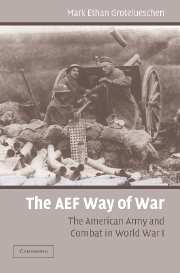Book contents
- Frontmatter
- Contents
- Acknowledgments
- Introduction
- 1 Doctrine, Dogma, and Development in the AEF
- 2 The 1st Division: Training for and Waging Trench Warfare
- 3 The 1st Division: The Search for a “Sufficiently Powerful Fire”
- 4 The 26th “Yankee” Division: Doctrine, Discipline, and Discrimination
- 5 The 26th “Yankee” Division: Doctrine, Demoralization, and Disintegration
- 6 The 2nd Division: Bloody Lessons in “Open Warfare”
- 7 The 2nd Division: The Rise of Set-Piece Battle
- 8 The 77th “Liberty” Division: Training for the Trenches and Fighting on the Vesle
- 9 The 77th “Liberty” Division: Dogma, Delegation, and Discretion
- 10 Conclusions
- References
- Index
8 - The 77th “Liberty” Division: Training for the Trenches and Fighting on the Vesle
Published online by Cambridge University Press: 29 August 2009
- Frontmatter
- Contents
- Acknowledgments
- Introduction
- 1 Doctrine, Dogma, and Development in the AEF
- 2 The 1st Division: Training for and Waging Trench Warfare
- 3 The 1st Division: The Search for a “Sufficiently Powerful Fire”
- 4 The 26th “Yankee” Division: Doctrine, Discipline, and Discrimination
- 5 The 26th “Yankee” Division: Doctrine, Demoralization, and Disintegration
- 6 The 2nd Division: Bloody Lessons in “Open Warfare”
- 7 The 2nd Division: The Rise of Set-Piece Battle
- 8 The 77th “Liberty” Division: Training for the Trenches and Fighting on the Vesle
- 9 The 77th “Liberty” Division: Dogma, Delegation, and Discretion
- 10 Conclusions
- References
- Index
Summary
The 77th Division, the first and most active of the draftee National Army divisions, had in many ways a remarkably different wartime experience than the 1st, 26th, and 2nd Divisions. As with other National Army divisions, it had from the very beginning fewer officers and NCOs who had spent any time in either the Regular Army or the National Guard. Possibly of more importance, the 77th accomplished most of its training in the United States and only ran through an abbreviated training regimen in France before being ordered into combat. This undoubtedly had an impact on the division's combat experience, probably by lowering its overall effectiveness but also by limiting the amount of exposure its men had to the AEF's official combat doctrine.
Among the most significant distinctions between the 77th Division and many other experienced divisions was that its longest serving commander, Major General Robert Alexander, seemed to adapt both his thinking and his methods very little during the year he spent in Europe. A devoted adherent of prewar American combat doctrine, Alexander's faith in the rifle, bayonet, and infantry maneuver as the keys to battlefield success never wavered, nor did his reliance on a decentralized style of command that pushed the responsibility for operational planning down to his brigade, regimental, and battalion commanders. Alexander's traditional doctrinal views and his philosophy of command combined to inhibit the division's ability to make the kind of adjustments and adaptations seen in the AEF's best divisions.
- Type
- Chapter
- Information
- The AEF Way of WarThe American Army and Combat in World War I, pp. 280 - 309Publisher: Cambridge University PressPrint publication year: 2006



